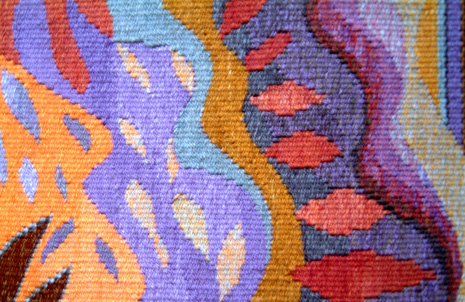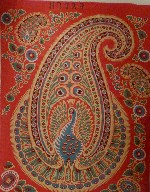Dyeing to Weave
By Tricia Gow
My interest in weaving started in childhood—I still have my first loom. As I grew older I went on to use my mother's tabby loom and then whilst training as an Occupational Therapist completed my first year "professionals" in weaving, woodwork, basketry and embroidery. In my paid work, I went on to be a youth and community worker and then worked with people with mental health problems using my artistic skills whenever possible. In 1978, after seeing an exhibition in Edinburgh which included tapestry weaving, I signed up for a class and was hooked into this wonderful medium. At that time I was raising my children and working part time and felt very nervous about trying to dye fibres in my kitchen. This all changed in 1991, when I started a wonderful journey learning about fungi dyes across Europe, the USA and Australia.

Some of you may know of the work of Miriam Rice, who during the 1960's in Mendocino, California, began working with natural dyes and, after joining a workshop "Introduction to Mushrooms," picked a clump of Sulphur tufts, put them in a pot of water and found it gave a yellow dye. My introduction was through a Danish mycologist who gave a talk to Scottish Weavers Spinners & Dyers on mushroom dyes. It was mind-blowing to see slides of fungi and dyed yarns. Following a practical demonstration that she gave after her talk, a few of us decided we had to take action take share this new dye source in Scotland and the UK. I still find it incredible that there seems to be no evidence of ancient man using fungi dyes. We started exploring our forests, identifying and dipping almost any fungi into hot water to see if there was any colour, we had lots of false starts! Gradually my anxieties about dyeing in my kitchen disappeared!
Since 1993 I have been travelling to the International Fungi & Fibre Symposiums which are hosted every two years by a different country (in 2014 we go to Estonia). That year we hosted the 6th International Fungi & Fibre Symposium at the Edinburgh Royal Botanic Gardens and welcomed Miriam Rice and fungi friends from the USA, Sweden, Norway, Denmark and Finland. They all wanted to help us explore and identify dye fungi in Scotland and learn the dye processes. We were joined by people from England, Germany, Australia and our efforts led to the formation of the Scottish Fungi Group known as "The Fungus Bunch," a UK inclusive group.
At these events I have exhibited my weavings, provided weaving workshops and collaborated with my fungi UK friends to make a group exhibits demonstrating different aspects of the use of fungi dyes. I currently co-ordinate a newsletter for the International Fungi & Fibre Federation. The Federation is made up of one representative from each of the 21 countries and we hold a meeting during the symposium. During the year between symposia I collate information for a newsletter which is published on the mushrooms for color website (www.mushroomsforcolor.com).
Initially we were able to get dye fungi by spending many a day in the undergrowth happy, to get even a handful or more! However we soon came to the conclusion that the way our land had been managed in terms of farming, forestry and urbanisation meant that habitats were no longer there or valued in the sense of maintaining the biodiversity of species. To that end the Scottish Fungi group members drew up a code of practice stating we can only pick for our own use, we do not sell fungi or provide workshops and only give demonstrations if we have sufficient of our own fungi. Since then the changing climate and habitats has made it far more difficult to find dye fungi, with the consequence that there are now less than 10 of us who actively find and dye with fungi.
In 2003, in Denmark, Western Australia I led a discussion on ethical harvesting. At that time in Scotland we had 600 commercially registered pickers for edible mushrooms and we were concerned that over-picking and damage to the environment would impact on all mushroom pickers (edible or dye fungi) resulting in local banning or broader legislation to ban picking. The response to this discussion from many of our colleagues from other countries (who have mushrooms in abundance) was to dismiss this as not being a problem. However, there has been a growing trade in edible mushrooms in Europe, fostered by open borders and restrictions in some countries but not in others. In the 2013 season, people were banned from picking any mushrooms. I believe this debate is important as commercial both registered and non-registered picking continues across borders. I am not convinced that the majority of pickers have any interest other than short term monetary gain!
Dyeing with Fungi
Some dye fungi release the dye on immersion in hot water, while others need an agent to raise the pH. I use alum mordant and recently have been experimenting with a cold mordant. Identification of the fungi used is key, so a book that provides good images and information is desirable.
Some of the dye fungi found in the UK that give good strong colour are C. Semi Sanguineus (reds/oranges), C. Cinnamomeus (oranges), Hapilopilus Nidulans (purple), Innonotus Hispidus (golds/yellows/browns), Paxillus Atromentosus (greens/bluey grey), and Phaeolus Schweinitzi (yellows).
|
Songline (detail). Tapestry, fungus-dyed yarns. |
||
|
|
||
| Photograph Copyright by Tricia Gow |
For tapestry weaving I like a range of colour from very deep to the paler shades. When I set up a dye pot, the thrill of seeing the colour take to the yarn is always there and different yarns and varying the pH produces many shades. Because in tapestry weaving I can use small to larger amounts depending on the design, I tend to set up a pot and dye rather than plan weight wise the amounts of yarn needed. I prefer a high twist pure wool yarn but have also dyed using my own handspun. When spinning I use and mix fibres like Merino, Blue Faced Leicester, silks, Alpaca, banana and bamboo fibres. The fungi dyes, although very different in intensity of colour, also have a way of working together. I like to mix my colour palette so rarely use a fibre on its own. You can see in the images the vibrancy of the colour and the way they work in the weave.
Further Reading
Rice, Miriam 2007. Mushrooms for Dyes, Paper, Pigments & Myco-Stix, Mushrooms for Color Press, Forestville, CA.
Lundmark, Hjordis and Hans Markland 2009. Fargsvampar & Svampfargning (written in Swedish) Bollstabruk : Motagg, ISBN 978-91-633-3615-7.
About the Author
Scotland is Tricia Gow's home and she has an abiding love of its colours, land and seascapes and history. She lives in Scotland in a small village to the west of Edinburgh called Balerno, near enough the city to go to events and far enough away to enjoy the peace of the countryside. Her interest in travelling has also provided opportunities to explore in more depth the Kimberley area, Queensland, Western Australia, Syria, Sicily and Turkey. Her web site is www.dyeingtoweave.co.uk.
 Turkey Red Journal
Turkey Red Journal
